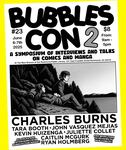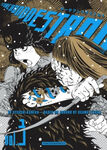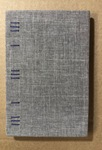
Through a hard won personal process developed over decades of his artistic practice, Mark Doox has merged the respective iconographies of Byzantine Christian art and racist American art, effecting a strange transformation whereby each becomes the other as they become one. A large selection of the mixed-media artworks that have emerged from this practice have been assembled together with artworks created specifically for this volume and then accompanied by a series of self-authored texts, which serve the dual purpose of providing exigetical commentary on the artworks themselves and advancing arguments which the artworks then serve to illustrate. The result is a cohesive – and one-of-a-kind – work that is at once a personal catharsis and an illuminated pathway to revelation.
The N*Word of God is a massive, 366 page, full color, embossed hardcover volume published by Fantagraphics – which may at first appear to be an anomalous choice of venue for this work. It quickly becomes apparent, however, that The N*Word of God shares much of the transgressive polemical spirit that animated the original generation of underground comics* which make up a significant part of the publishing history of Fantagraphics. And they have done right by this book – with the able guidance of creative director and graphic designer, Kayla E. – providing the requisite physical container for its fullest appreciation and a level of production values commensurate to the epic labor that it embodies.
Rife with parable and paradox**, as is wholly appropriate for a work that is presented in the guise of a religious text, Doox’s artwork – the formal techniques of which he developed in part through working with Kerry James Marshall, and which he sometimes refers to as "Byz-Dada" (as in Byzantine-Dadaism) – is resplendent, attractive and, yes, spiritual, but also startling and jarring in its imagery***, demanding intellectual engagement and response. Doox has appropriated a wealth of iconic (literally) religious imagery – most notably Byzantine (see above) – and surgically spliced it onto, mashed it up in and integrated it with appropriations of American imagery from the 19th century to the present, derived from commercial advertising and "patriotic" art, as well as original portraiture, life studies, historical photographs, and other imagery derived from American culture (including superhero comics), and then positioned at the center of it all the iconic racist imagery of blackface minstrelsy, in the process creating a definitive work of iconoclasm which achieves some of the most profound ironies imaginable.
Although there is some degree of image processing involved in the assembling and arranging of the images into the book we have before us, the basic images are derived from Doox's pre-existent art-making practice in which the collagist intelligence of Romare Bearden is deftly applied to classical and contemporary images, often with an intent to foreground their inherent iconographic and symbolic qualities. Some of the pieces also bring to mind the agit-prop of John Heartfield, while others appear leavened with the irreverence of Terry Gilliam's animations for Monty Python.
These visual elements are then spliced onto a large and complex text that takes a dialectical approach, deconstructing concepts of and relations between color, race and human being employing representations of language that simultaneously embrace and parody both the linguistic cadences and the orthographies of traditional Christian liturgies – interspersed throughout with humor that is by turns bitter, mirthful and wry – to outline and articulate both thesis and antithesis so as to forge a bracing synthesis that amply illustrates the inherent absurdity of color-based racial categories and, ultimately, the very concept of race itself.
While there are ample references to recent history and current events, and the book may read at times as though it is embodying, to varying degrees, a satiric response to the heightened – and often overtly racialized – polarization of politics that were a hallmark of the Trump years (and very much still with us), the work as a whole clearly reveals Doox as operating largely above the fray with broader concerns in mind. In the pages of Stamped from the Beginning, Ibram X. Kendi diagrammed the way in which racism as an institution was deliberately constructed in an act of self interest on the part of a contingent of the wealthy and powerful, as a means by which to perpetuate their power and control. Here in the text of The N*Word of God, Doox represents that construct as a labyrinth, replete with the feints and false exits of racialized thinking and circular reasoning leading to blind alleys and dead ends conflating deluded concepts of right & wrong with imaginary binaries of Black & White – and then provides readers with a map showing a way out through the embracing of a universal acknowledgement of a shared common humanity. Doox has been deeply engaged with the uplifting spirituality of The Coltrane Church which strives for a universalist, humanistic approach to religion – A Love Supreme – and for which Doox has long served as the ordained iconographer. This universalist, humanistic ethos undergirds the entire work, and proves ultimately to be its primary animating force.
The N*Word of God is a challenging and complex satire of American mores that arrives at a propitious time. Efforts expended towards its comprehension will be rewarded with a commensurate increase in understanding of the artifice and illusion underpinning constructions of race in America, as well as the provision of a hope for a better future for us all.
To explore this work further, read an in-depth – and insightful – interpretation by Yanan Rahim Navarez Melo at Sojourners, HERE.
–––––––––––––
*R. Crumb in particular, whose infamous early work involving racial caricature may be informative here
**and helpfully citing a signature Magritte work at the outset to provide perspective
***which, in the tradition of underground comics, will certainly be disturbing to some










